srs TOYOTA YARIS HATCHBACK 2020 (in English) User Guide
[x] Cancel search | Manufacturer: TOYOTA, Model Year: 2020, Model line: YARIS HATCHBACK, Model: TOYOTA YARIS HATCHBACK 2020Pages: 572, PDF Size: 7.94 MB
Page 68 of 572
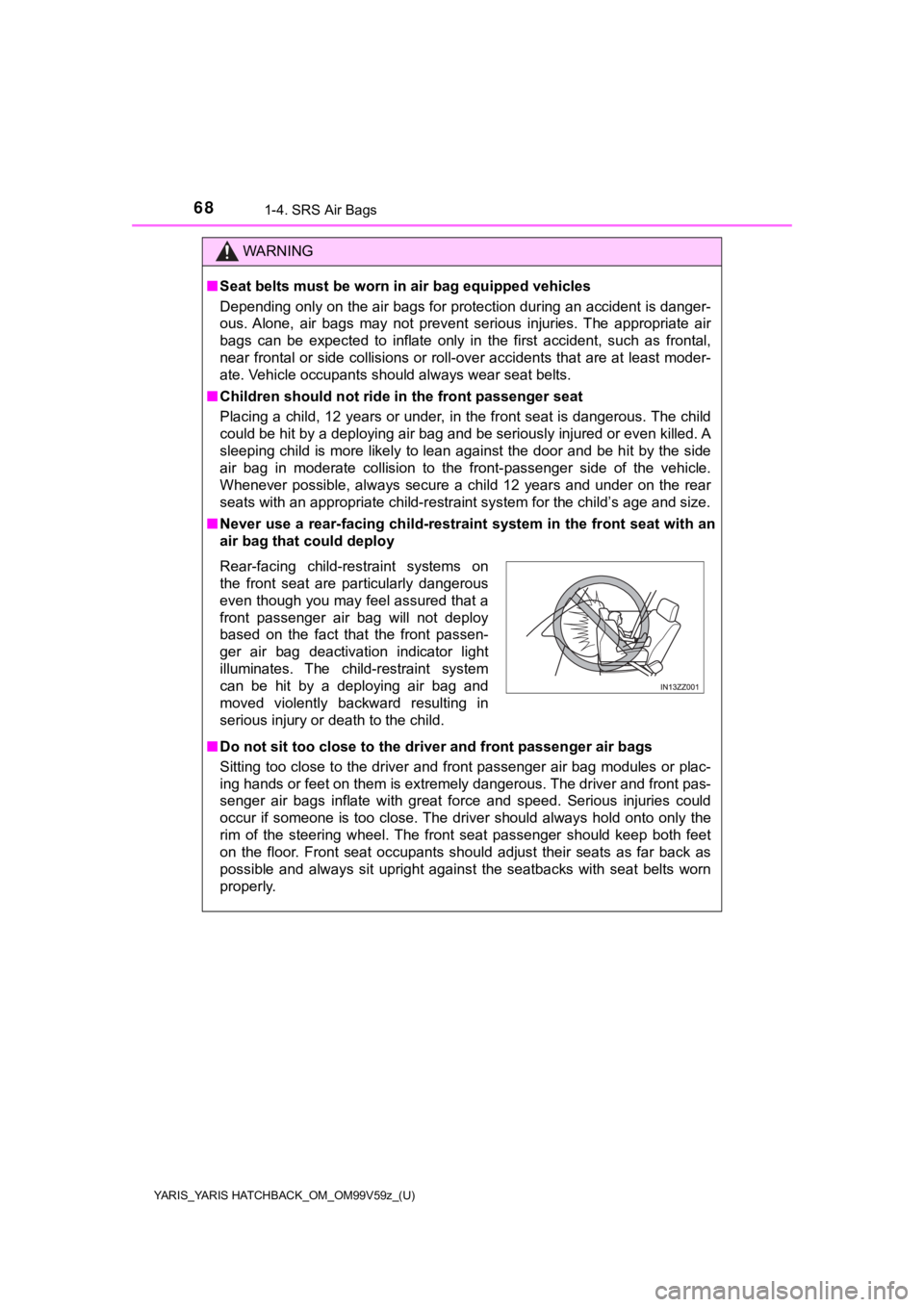
68
YARIS_YARIS HATCHBACK_OM_OM99V59z_(U)
1-4. SRS Air Bags
WARNING
■Seat belts must be worn in air bag equipped vehicles
Depending only on the air bags for protection during an acciden t is danger-
ous. Alone, air bags may not prevent serious injuries. The appr opriate air
bags can be expected to inflate only in the first accident, suc h as frontal,
near frontal or side collisions or roll-over accidents that are at least moder-
ate. Vehicle occupants should always wear seat belts.
■ Children should not ride in the front passenger seat
Placing a child, 12 years or under, in the front seat is danger ous. The child
could be hit by a deploying air bag and be seriously injured or even killed. A
sleeping child is more likely to lean against the door and be h it by the side
air bag in moderate collision to the front-passenger side of th e vehicle.
Whenever possible, always secure a child 12 years and under on the rear
seats with an appropriate child-restraint system for the child’s age and size.
■ Never use a rear-facing child-restraint system in the front sea t with an
air bag that could deploy
■ Do not sit too close to the driver and fron t passenger air bags
Sitting too close to the driver and front passenger air bag modules or plac-
ing hands or feet on them is extremely dangerous. The driver an d front pas-
senger air bags inflate with great force and speed. Serious injuries could
occur if someone is too close. The driver should always hold on to only the
rim of the steering wheel. The front seat passenger should keep both feet
on the floor. Front seat occupants should adjust their seats as far back as
possible and always sit upright against the seatbacks with seat belts worn
properly.
Rear-facing child-restraint systems on
the front seat are particularly dangerous
even though you may feel assured that a
front passenger air bag will not deploy
based on the fact that the front passen-
ger air bag deactivation indicator light
illuminates. The child-restraint system
can be hit by a deploying air bag and
moved violently backward resulting in
serious injury or death to the child.
Page 69 of 572

YARIS_YARIS HATCHBACK_OM_OM99V59z_(U)
691-4. SRS Air Bags
1
Essential Safety Equipment
WARNING
■Sit in the center of the seat and wear seat belts properly
Sitting too close to the side air bag modules or placing hands on them, or
sleeping up against the door or hanging out the windows is extr emely dan-
gerous. The side and curtain air bags inflate with great force and speed
directly expanding along the door on the side the car is hit. S erious injury
could occur if someone is sitting too close to the door or lean ing against a
window, or if rear seat occupants grab the sides of the front s eatbacks. Give
the side and curtain air bags room to work by sitting in the ce nter of the seat
while the vehicle is moving with seat belts worn properly.
■ Do not attach objects on or around the area where driver and fr ont pas-
senger air bags deploy
Attaching an object to the driver and front passenger air bag m odules or
placing something in front of them is dangerous. In an accident, an object
could interfere with air bag inflation and injure the occupants .
■ Do not attach objects on or around the area where a side air ba g
deploys
Attaching objects to the front seat in such a way as to cover t he outboard
side of the seat in any way is dangerous. In an accident the ob ject could
interfere with the side air bag, which inflates from the outboa rd side of the
front seats, impeding the added protection of the side air bag system or
redirecting the air bag in a way that is dangerous. Furthermore , the bag
could be cut open releasing the gas.
Do not hang net bags, map pouches, backpacks with side straps o r any
other objects on the front seats. Never use seat covers on the front seats.
Always keep the side air bag modules in your front seats free t o deploy in
the event of a side collision.
■ Do not attach objects on or around the area where a curtain air bag
deploys
Attaching objects to the areas where the curtain air bag activa tes such as
on the windshield glass, side door glass, front and rear window pillars and
along the roof edge and assist grips is dangerous. In an accide nt the object
could interfere with the curtain air bag, which inflates from t he front and rear
window pillars and along the roof edge, impeding the added prot ection of
the curtain air bag system or redirecting the air bag in a way that is danger-
ous. Furthermore, the bag could be cut open releasing the gas.
Do not place hangers or any other objects on the assist grips. When hang-
ing clothes, hang them on the coat hook directly. Always keep the curtain air
bag modules free to deploy in the event of a side collision or roll-over acci-
dent.
Page 70 of 572

70
YARIS_YARIS HATCHBACK_OM_OM99V59z_(U)
1-4. SRS Air Bags
WARNING
■Do not touch the components of t he supplemental restraint system
after the air bags have inflated
Touching the components of the supplemental restraint system after the air
bags have inflated is dangerous. Immediately after inflation, t hey are very
hot. You could get burned.
■ Never install any front-end equipment to your vehicle
Installation of front-end equipment, such as frontal protection bar (kangaroo
bar, bull bar, push bar, or other similar devices), snowplow, o r winches, is
dangerous. The air bag crash sensor system could be affected. T his could
cause air bags to inflate unexpectedly, or it could prevent the air bags from
inflating during an accident. Front occupants could be seriously injured.
■ Do not modify the suspension
Modifying the vehicle suspension is dangerous. If the vehicle’s height or the
suspension is modified, the vehicle will be unable to accurately detect a col-
lision or roll-over accident resulting in incorrect or unexpect ed air bag
deployment and the possibility of serious injuries.
■ To prevent false detection by t he air bag sensor system, heed t he fol-
lowing
● Do not use tires or wheels other than those specified for your To y o t a :
Use of any tire or wheel other than those specified for your To yota (P. 553)
is dangerous. Use of such wheels will prevent the vehicle’s acc ident detec-
tions system from accurately detecting a collision or roll-over accident result-
ing in incorrect or unexpected air bag deployment and the possi bility of
serious injuries.
● Do not overload your vehicle:
Overloading your vehicle is dangerous as it could prevent the a ir bag
crash sensor system from accurately detecting a collision or roll-over acci-
dent resulting in incorrect or unexpected air bag deployment an d the pos-
sibility of serious injuries. The gross axle weight rating (GAW R) and the
gross vehicle weight rating (GVWR) for your vehicle are on the Motor
Vehicle Safety Standard Label on the driver’s door frame. Do not exceed
these ratings.
● Do not drive the vehicle off-road:
Driving your Toyota off-road is dangerous because the vehicle h as not
been designed to do so. Driving the vehicle off-road could prevent the air
bag crash sensor system from accurately detecting a collision o r roll-over
accident resulting in incorrect or unexpected air bag deploymen t and the
possibility of serious injuries.
Page 71 of 572

YARIS_YARIS HATCHBACK_OM_OM99V59z_(U)
711-4. SRS Air Bags
1
Essential Safety Equipment
WARNING
■Do not modify a front door or l eave any damage unrepaired. Always
have your Toyota dealer ins pect a damaged front door
Modifying a front door or leaving any damage unrepaired is dang erous.
Each front door has a side crash sensor as a component of the supplemen-
tal restraint system. If holes are drilled in a front door, a door speaker is left
removed, or a damaged door is left unrepaired, the sensor could be
adversely affected causing it to not detect the pressure of an impact cor-
rectly during a side collision. If a sensor does not detect a s ide impact cor-
rectly, the side and curtain air bags and the front seat belt pretensioner may
not operate normally which could result in serious injury to oc cupants.
■ Do not modify the supplemental restraint system
Modifying the components or wiring of the supplemental restrain t system is
dangerous. You could accidentally activate it or make it inoper able. Do not
make any modifications to the supplemental restraint system. Th is includes
installing trim, badges, or anything else over the air bag modu les. It also
includes installing extra electrical equipment on or near syste m components
or wiring. Your Toyota dealer can provide the special care need ed in the
removal and installation of front seats. It is important to protect the air bag
wiring and connections to assure that the bags do not accidenta lly deploy,
and that the front passenger occupant classification system and the seats
retain an undamaged air bag connection.
■ Do not place luggage or other objects under the front seats
Placing luggage or other objects under the front seats is dange rous. The
components essential to the supplemental restraint system could be dam-
aged, and in the event of a side collision, the appropriate air bags may not
deploy, which could result in death or serious injury. To preve nt damage to
the components essential to the supplemental restraint system, do not
place luggage or other objects under the front seats.
■ Do not operate a vehicle with damaged air bag/seat belt pretens ioner
system components
Expended or damaged air bag/seat belt pretensioner system components
must be replaced after any collision which caused them to deplo y or dam-
age them. Only a trained Authorized Toyota Dealer can fully eva luate these
systems to see that they will work in any subsequent accident. Driving with
an expended or damaged air bag or pretensioner unit will not afford you the
necessary protection in the event of any subsequent accident wh ich could
result in serious injury or death.
Page 72 of 572

72
YARIS_YARIS HATCHBACK_OM_OM99V59z_(U)
1-4. SRS Air Bags
WARNING
■Do not remove interior air bag parts
Removing any components such as the front seats, front dashboar d, the
steering wheel or parts on the front and rear window pillars an d along the
roof edge, containing air bag parts or sensors is dangerous. Th ese parts
contain essential air bag components. The air bag could accidentally acti-
vate and cause serious injuries. Always have your Toyota dealer remove
these parts.
■ Properly dispose of the air bag system
Improper disposal of an air bag or a vehicle with live air bags in it can be
extremely dangerous. Unless all safety procedures are followed, injury
could result. Have your Toyota dealer safely dispose of the air bag system
or scrap an air bag equipped vehicle.
Page 73 of 572
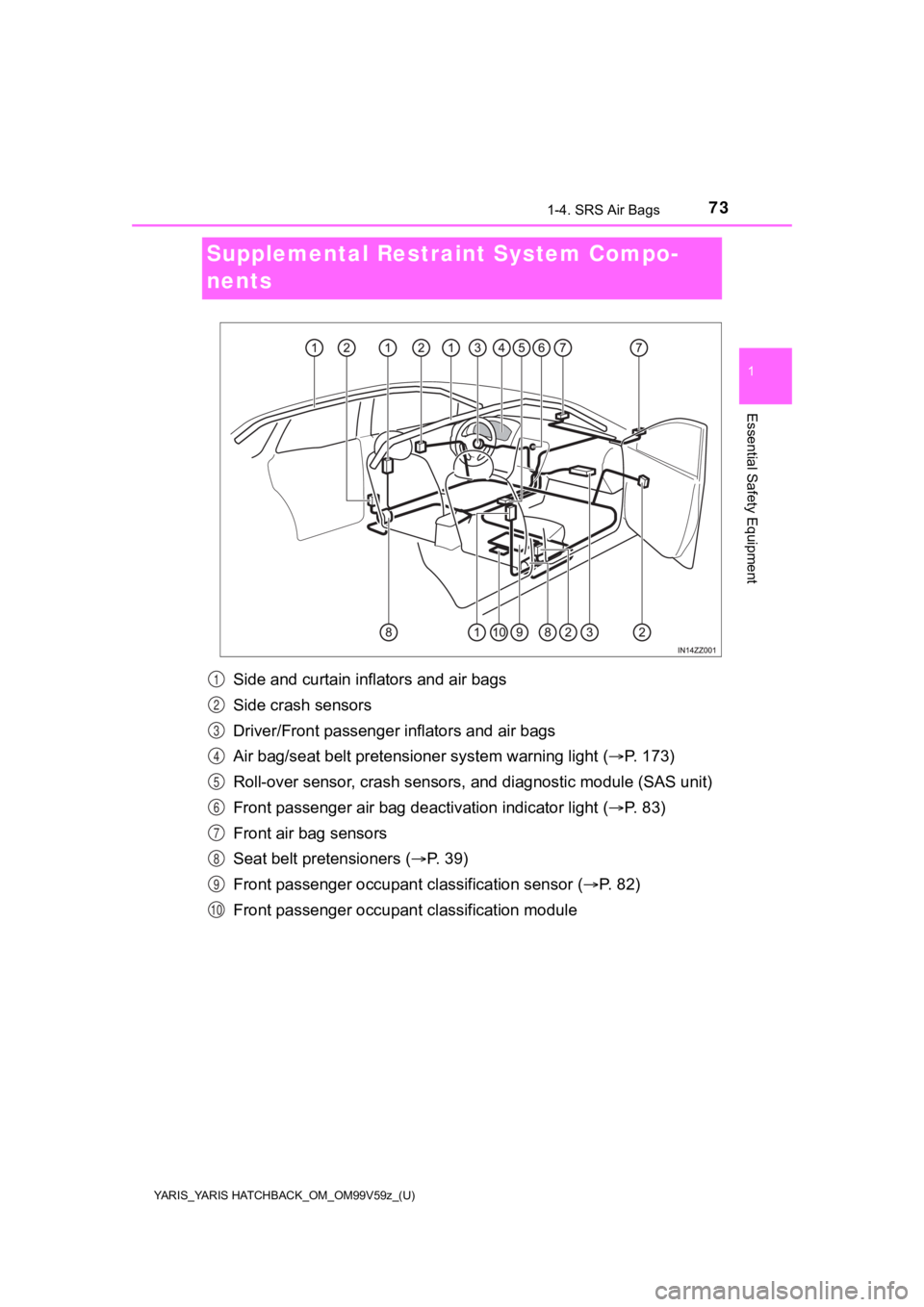
73
YARIS_YARIS HATCHBACK_OM_OM99V59z_(U)
1-4. SRS Air Bags
1
Essential Safety Equipment
Supplemental Restraint System Compo-
nents
Side and curtain inflators and air bags
Side crash sensors
Driver/Front passenger inflators and air bags
Air bag/seat belt pretensi oner system warning light ( P. 173)
Roll-over sensor, crash sensors, and diagnostic module (SAS uni t)
Front passenger air bag deac tivation indicator light (P. 8 3 )
Front air bag sensors
Seat belt pretensioners ( P. 3 9 )
Front passenger occupant c lassification sensor (P. 8 2 )
Front passenger occupant classification module1
2
3
4
5
6
7
8
9
10
Page 74 of 572
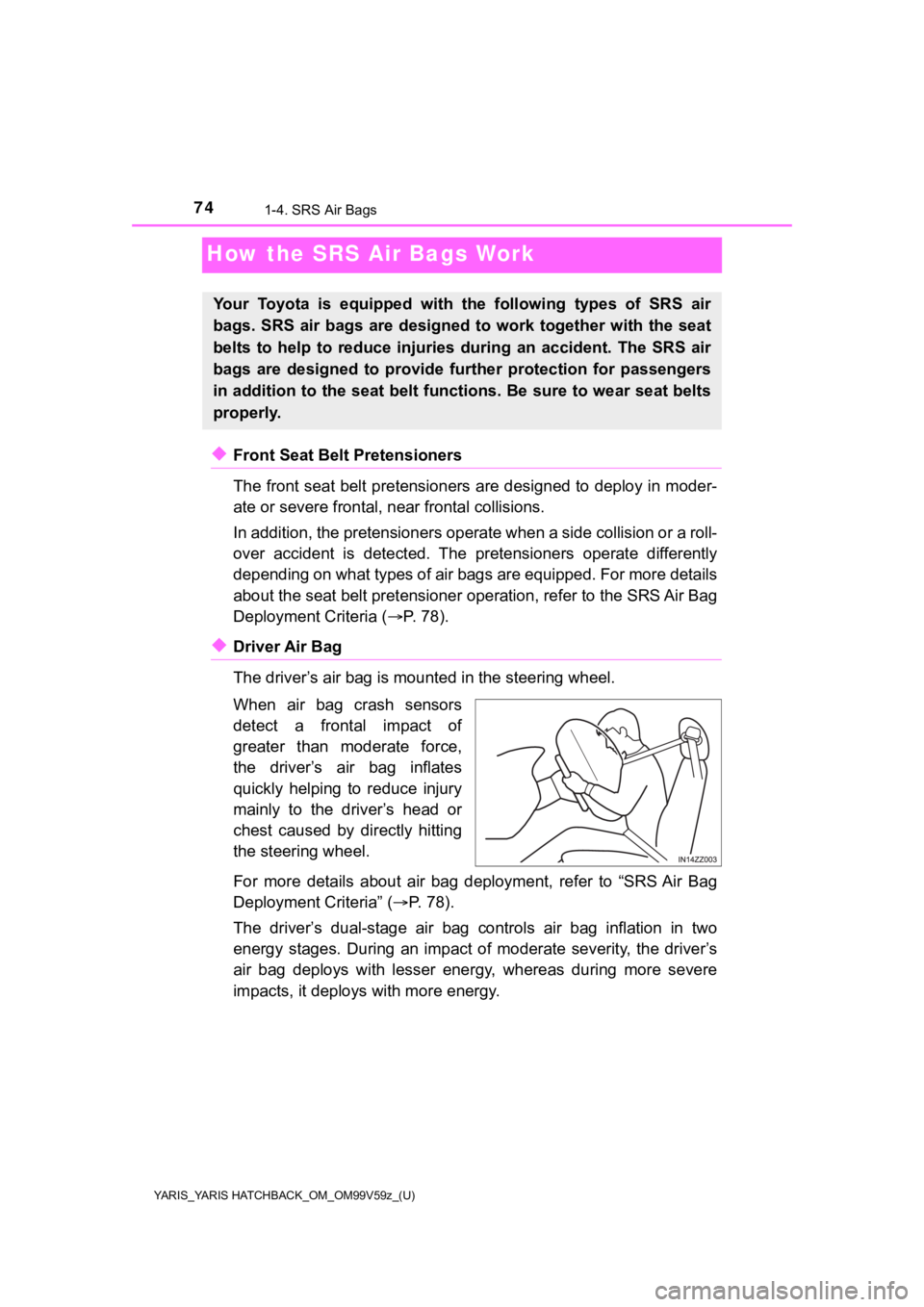
74
YARIS_YARIS HATCHBACK_OM_OM99V59z_(U)
1-4. SRS Air Bags
How the SRS Air Bags Work
◆Front Seat Belt Pretensioners
The front seat belt pretensioners are designed to deploy in moder-
ate or severe frontal, near frontal collisions.
In addition, the pretensioners o perate when a side collision or a roll-
over accident is detected. The p retensioners operate differently
depending on what types of air bags are equipped. For more deta ils
about the seat belt pretensioner operation, refer to the SRS Ai r Bag
Deployment Criteria ( P. 7 8 ) .
◆Driver Air Bag
The driver’s air bag is mounted in the steering wheel.
When air bag crash sensors
detect a frontal impact of
greater than moderate force,
the driver’s air bag inflates
quickly helping to reduce injury
mainly to the driver’s head or
chest caused by directly hitting
the steering wheel.
For more details about air bag deployment, refer to “SRS Air Ba g
Deployment Criteria” ( P. 7 8 ) .
The driver’s dual-stage air bag controls air bag inflation in t wo
energy stages. During an impact of moderate severity, the driver’s
air bag deploys with lesser energy, whereas during more severe
impacts, it deploys with more energy.
Your Toyota is equipped with the following types of SRS air
bags. SRS air bags are designed to work together with the seat
belts to help to reduce injuries during an accident. The SRS ai r
bags are designed to provide further protection for passengers
in addition to the seat belt functions. Be sure to wear seat be lts
properly.
Page 75 of 572
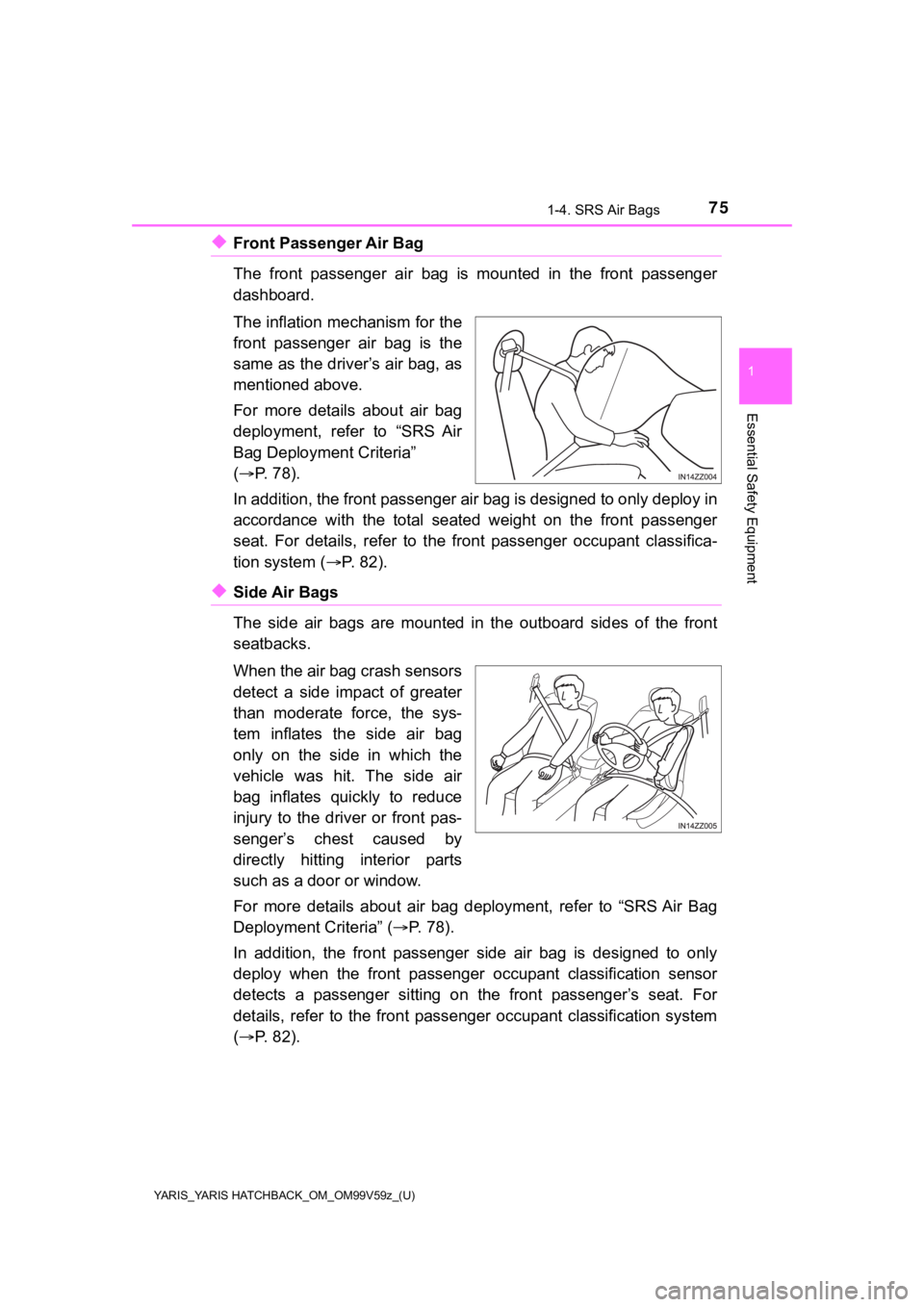
YARIS_YARIS HATCHBACK_OM_OM99V59z_(U)
751-4. SRS Air Bags
1
Essential Safety Equipment
◆Front Passenger Air Bag
The front passenger air bag is mounted in the front passenger
dashboard.
The inflation mechanism for the
front passenger air bag is the
same as the driver’s air bag, as
mentioned above.
For more details about air bag
deployment, refer to “SRS Air
Bag Deployment Criteria”
( P. 78).
In addition, the front passenger air bag is designed to only de ploy in
accordance with the total seated weight on the front passenger
seat. For details, refer to the front passenger occupant classi fica-
tion system ( P. 8 2 ) .
◆Side Air Bags
The side air bags are mounted in the outboard sides of the fron t
seatbacks.
When the air bag crash sensors
detect a side impact of greater
than moderate force, the sys-
tem inflates the side air bag
only on the side in which the
vehicle was hit. The side air
bag inflates quickly to reduce
injury to the driver or front pas-
senger’s chest caused by
directly hitting interior parts
such as a door or window.
For more details about air bag deployment, refer to “SRS Air Ba g
Deployment Criteria” ( P. 7 8 ) .
In addition, the front passenger side air bag is designed to on ly
deploy when the front passenger occupant classification sensor
detects a passenger sitting on the front passenger’s seat. For
details, refer to the front pas senger occupant classification s ystem
( P. 82).
Page 76 of 572
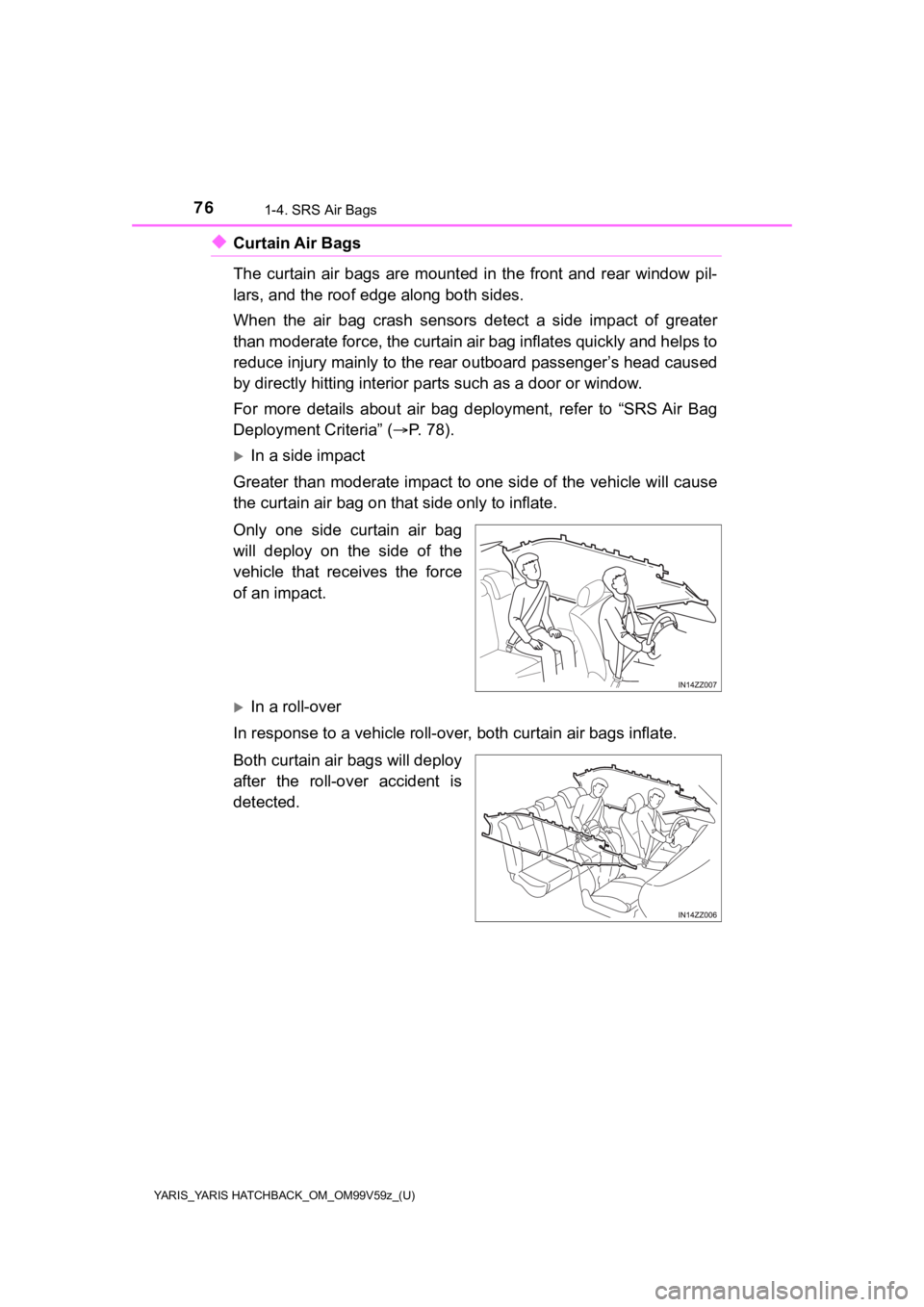
76
YARIS_YARIS HATCHBACK_OM_OM99V59z_(U)
1-4. SRS Air Bags
◆Curtain Air Bags
The curtain air bags are mounted in the front and rear window pil-
lars, and the roof edge along both sides.
When the air bag crash sensors detect a side impact of greater
than moderate force, the curtain air bag inflates quickly and h elps to
reduce injury mainly to the rear outboard passenger’s head caus ed
by directly hitting interior p arts such as a door or window.
For more details about air bag deployment, refer to “SRS Air Ba g
Deployment Criteria” ( P. 7 8 ) .
In a side impact
Greater than moderate impact to one side of the vehicle will ca use
the curtain air bag on that side only to inflate.
Only one side curtain air bag
will deploy on the side of the
vehicle that receives the force
of an impact.
In a roll-over
In response to a vehicle roll-over , both curtain air bags inflate.
Both curtain air bags will deploy
after the roll-over accident is
detected.
Page 77 of 572

YARIS_YARIS HATCHBACK_OM_OM99V59z_(U)
771-4. SRS Air Bags
1
Essential Safety Equipment
◆Warning Light/Beep
A system malfunction or operation conditions are indicated by a
warning.
Refer to Warning/Indi cator Lights on P. 173.
Refer to Warning Sound i s Activated on P. 502.